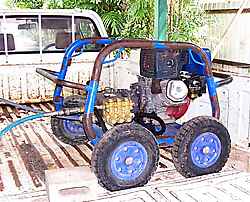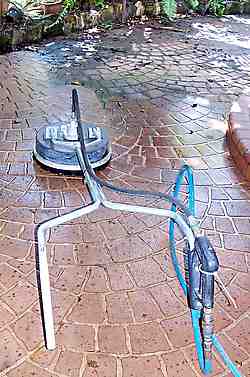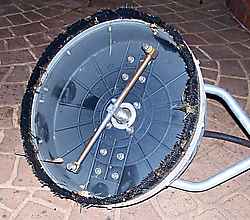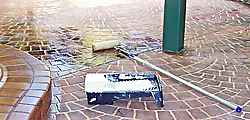 |
||||||||||||||||
Pressure cleaner, water blasting and sealing a concrete slab.
The stamped concrete was done about ten years ago and was sealed when it was new. Unfortunately the owner (that's me) has been a bit slack and not bothered re-sealing it, ever. Concrete like this in an area that gets watered every day, should be re-sealed say about every two or three years to keep the mildew at bay, and the surface looking good and easy to clean. I actually own a small 2000 psi (pounds per square inch) pressure cleaner that is good for small jobs. I bought it when I was screen printing, to pressure clean the screens, and I have even used it to clean my roof down, but for this job I hired a larger one. The larger 3000 psi machine that I hired from our local Coates Hire branch, more than paid for it's hire, in ease of use and speed. You may think that the jump from 2000 psi to 3000 psi is small and why didn't I save a bit of cash, seeing as I am retired now and my time is not all that important. The reason I forked out around $140 a day for a larger petrol engine pressure cleaner is this.
What a bummer, I considered bolting a couple of forks onto the bottom of the trolley, but I thought that the weight of the pots might break the thing. I cast about and here's what I came up with. A five minute alteration to an old wheely bin that I had lying about. It worked a treat. Now before you start, I bought the old bin at our recycling shop at the dump. Honest! Trust me, I wouldn't vandalise council property, no way! Not even to save the risk of a hernia. Leave pressure cleaner and back to home page. Not found it yet? Try this FAST SITE SEARCH or the whole web |
Hire Equipment  Furniture Fittings - Architectural Hardware - Electronic Locking Systems - Technical Hardware BuilderBill sponsorship Other Miscellaneous Single Hints and Tips Pages.
|
|||||||||||||||
|
|
||||||||||||||||
|
Please Note! The information on this site is offered as a guide only! When we are talking about areas where building regulations or safety regulations could exist,the information here could be wrong for your area. It could be out of date! Regulations breed faster than rabbits! You must check your own local conditions. Copyright © Bill Bradley 2007-2012. All rights reserved. |
||||||||||||||||





